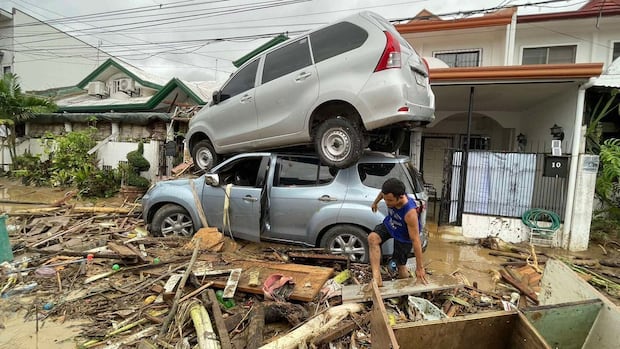Typhoon Kalmaegi has left at least 26 people dead in the Philippines, mostly in flooding set off by the storm, which barrelled across the central part of the country on Tuesday, disaster response officials said.
Floodwaters trapped scores of people on their roofs and submerged cars.
A further six people were killed when a Philippine Air Force helicopter crashed in a separate incident in southern Agusan del Sur province while transporting humanitarian aid to provinces battered by Kalmaegi.
The bodies of all those aboard the Super Huey chopper that crashed near Loreto town were recovered after a search, the military’s Eastern Mindanao Command said in a statement without providing other details, including what could have caused the crash.
Kalmaegi was last spotted over the coastal waters of Jordan town in the central province of Guimaras with sustained winds of 130 km/h and gusts of up to 180 km/h. It was forecast to blow into the South China Sea late Tuesday or early Wednesday after hitting the western province of Palawan.
Many deaths due to flooding
Bernardo Rafaelito Alejandro IV, deputy administrator of the Office of Civil Defence, said that at least 26 people were reported killed — many in flooding in Cebu province and other central island provinces pummelled by Kalmaegi, the 20th tropical cyclone to batter the Philippine archipelago this year. Details of those typhoon deaths were still being verified, he said.
Among the dead was an older villager who drowned in floodwaters in Southern Leyte, where a provincewide power outage was reported after the typhoon made landfall around midnight in one of its eastern towns. A resident died after being hit by a fallen tree in central Bohol province, provincial officials said.
WATCH | Floodwaters sweep through Philippines:
Typhoon Kalmaegi brought powerful winds, heavy rain and dangerous flooding to parts of the Philippines, including areas in Cebu, where video showed inundated streets and rescue efforts.
Gwendolyn Pang, secretary general of the Philippine Red Cross, said that an unspecified number of residents were trapped on their roofs by floodwaters in the coastal town of Liloan in Cebu, and added that cars were submerged in floods or floated in another Cebu community.
“We have received so many calls from people asking us to rescue them from roofs and from their houses, but it’s impossible,” Pang told The Associated Press on Tuesday morning. “There are so many debris, you see cars floating so we have to wait for the flood to subside.”
Cebu province was still recovering from a 6.9-magnitude earthquake on Sept. 30 that left at least 79 people dead and displaced thousands when houses collapsed or were severely damaged.
PHOTOS | The aftermath of Typhoon Kalmaegi:
Wind ripped off roofs
In Eastern Samar, one of the east-central provinces first lashed by Kalmaegi early Tuesday, fierce wind ripped off roofs or damaged about 300 mostly rural shanties on the island community of Homonhon, which is part of the town of Guiuan. But there were no reported deaths or injuries, Mayor Annaliza Gonzales Kwan said.
“There was no flooding at all, but just strong wind,” Kwan told the AP by telephone. “We’re OK. We’ll make this through. We’ve been through a lot, and bigger than this.”

In November 2013, Typhoon Haiyan, one of the most powerful tropical cyclones on record, slammed ashore into Guiuan. It then raked across the central Philippines, leaving more than 7,300 people dead or missing, flattening entire villages and sweeping scores of ships inland.
Haiyan demolished about one million houses and displaced more than four million people in one of the country’s poorest regions.
The Philippines is battered by about 20 typhoons and storms each year. The country also is often hit by earthquakes and has more than a dozen active volcanoes, making it one of the world’s most disaster-prone countries.






